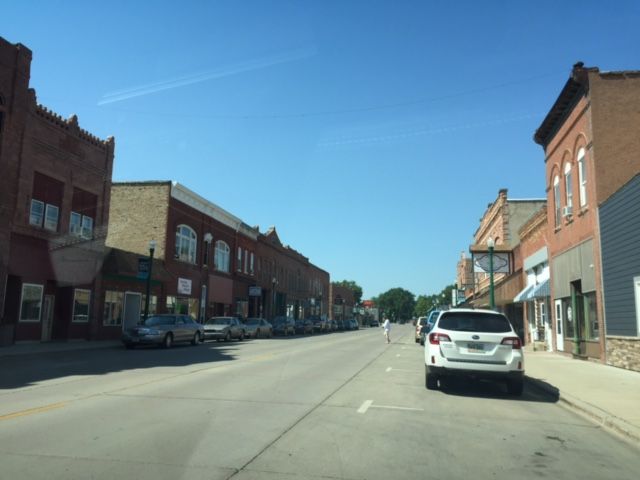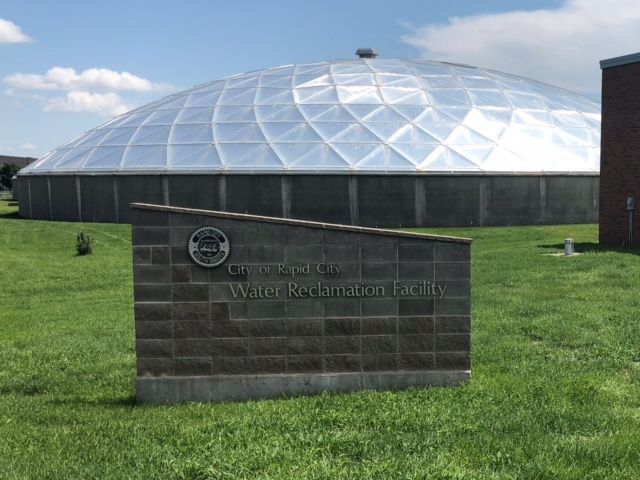Fixing the aging, often overworked systems that treat municipal wastewater in South Dakota would cost nearly $160 million, a cost borne mostly by state residents whose drinking water could be at stake.
Officials with the state Department of Environment and Natural Resources said in an email to News Watch that “the biggest issue facing wastewater treatment in South Dakota and the United States is repair and replacement of aging infrastructure, along with funding for new technologies.”
System upgrades are critical to improving the water quality in state rivers because pollution from aging systems could taint the drinking water supplies of some state residents.
In all, 98 South Dakota municipalities get drinking water from surface water sources, almost exclusively rivers. Seven municipalities have dedicated surface water systems and 91 buy their water from rural systems that use surface water as the source, according to Brian Walsh, spokesman for the state DENR. The Missouri River is the source for many of those drinking water systems.
The 20 biggest cities in South Dakota dump nearly 50 million gallons of treated sewage into state rivers each day, according to a News Watch analysis. Though most cities have upgraded their systems over the years, many were built decades ago. Mobridge, which dumps into the Missouri River, built its system in 1958, while Belle Fourche opened its system that dumps into a small creek in 1959. Rapid City built its system in 1967 and Sioux Falls opened its system in 1985, though both cities have done updates since then. The average age of the core elements of the systems in the largest 20 cities is 41.2 years.
Inspection and permit records reveal that older treatment systems often have trouble meeting pollution limits. The town of Sinai — a hamlet of about 120 people in southwestern Brookings County – had a mechanical treatment system built in 1979 that frequently violated wastewater standards. The city was cited for 176 violations of biological oxygen demand, acidity and total suspended solids released between 2008 and 2015, according to state inspection data. The system dumped 15,000 gallons of wastewater per day into Bolstad Slough.
In 2016, the state ordered the town to build a new system, and using local and state funds, a two-cell stabilization pond system was built for $1.5 million. Since then, discharges into the slough have stopped and no new effluent violations have been reported, according to the DENR.
The DENR said the State Water Plan, which guides project proposals and funding, includes 36 identified but unfunded wastewater projects of various types with a combined cost of $157 million.
Building new systems or upgrading old ones puts pressure on local officials to make sound decisions and forge a balance between cost and water quality outcomes.
On occasion, high growth can dictate a change.
Dan Fink, maintenance superintendent for the city of Harrisburg, among the state’s fastest-growing cities, said that community is in the midst of a debate over building a new wastewater system or continuing to pipe waste to the Sioux Falls Water Reclamation Facility for treatment. The decision comes amid resident complaints over occasional odors from the existing lagoon system.
“This is a multi-million-dollar decision as to which would be better for the taxpayers,” Fink said.
According to the city’s website, Harrisburg in 2015 was offered a long-term option to continue pumping waste to Sioux Falls at a cost of up to $30 million over 20 years. The price tag led the city to hire an engineering firm that created two options for a new system that would cost $15 million to $20 million. Meanwhile, Harrisburg officials are talking with neighboring cities of Tea and Worthing to explore a shared system. The issue remains unsettled, Fink said.
“The biggest factor is Harrisburg wants control of its own destiny, that’s what I keep hearing,” Fink said. “I do know that they (local residents) are going to pay substantially more for whatever we’re going to do.”

Billions needed for nation, neighboring states
The upgrades needed in South Dakota pale compared to the potential cost to the nation and neighboring states.
The U.S. Environmental Protection Agency estimates that $271 billion in deficiencies need repair at treatment plants across the country. Half of the nation’s roughly 22,000 wastewater facilities need repair or replacement, the agency said. Iowa, Minnesota and Nebraska all need more than $2 billion in system upgrades. Montana needs $363 million in upgrades while North Dakota needs $219 million and Wyoming needs $91 million.
The great need comes as federal funding for system upgrades and other state regulatory functions has been steady or falling in South Dakota and other states in recent years.
The DENR gets about a third of its funding from the federal government; the state pays one quarter, and fees make up about 40 percent.
In 2012, the state received about $1.66 million in federal money; that fluctuated but fell to $1.58 million in 2017. In an email, Walsh noted that President Donald Trump has proposed significant cuts of 30 to 40 percent in funding for some state wastewater programs, with some efforts possibly cut out completely.
DENR officials now say their 10-person permit and inspection team is fully staffed for the first time in six years. The staffing increase was enabled by passage of a measure by the 2018 South Dakota Legislature creating a new stormwater discharge fee placed on developers and municipalities and increasing the wastewater discharge permit fee for the first time in 25 years. The DENR lobbied heavily in favor of the measure.
Up to 95 percent of the cost of improving sewer systems is typically placed upon state and local taxpayers and users, which has proven true when South Dakota municipalities have undertaken costly and time-consuming system upgrades.
To encourage upgrades of wastewater facilities, the state holds $57 million in its Clean Water State Revolving Fund that was formed in 1989. Over the years, more than $667 million in loans have been made from that fund to improve wastewater systems in South Dakota.
Small communities have a harder time paying for system upgrades because they have difficulty raising millions in revenues from small tax and customer bases.
About two-thirds of systems in need of upgrade across the country are in cities of 3,500 people or less, according to the EPA. Eight of 10 outdated systems are in cities under 10,000 population. In South Dakota, the need in small communities is even more pronounced: about 80 percent of municipalities with an identified need have populations of 3,500 or less.
But bigger cities also face major investments. Rapid City may spend up to $62 million and Sioux Falls is considering $260 million in wastewater upgrades over the next several years.
South Dakota industries have also spent millions to improve wastewater treatment systems, often after state inspections reveal pollution problems.
After numerous violations in the early 2000s, the Valley Queen Cheese factory in Milbank spent $3.5 million to build a treatment system in 2005 and $6.5 million since then, the company said.
The Smithfield Foods plant in Sioux Falls upgraded its wastewater system in the mid-2010s. The plant still faces issues, including the July release of extreme ammonia levels that violated state limits and endangered fish in the Big Sioux River.
Just keeping municipal systems operational is a big expense for local taxpayers.
Sioux Falls spends about $22.5 million a year to run its treatment plant, Rapid City spends about $12.6 million, and the cities of Huron, Mitchell and Spearfish pay about $2 million a year. Vermillion and Madison spend about $1.5 million annually, while Mobridge spends $465,000 and Tea about $350,000.

A $5 million upgrade
Blame it on the weather or poor performance by microbes, but the city of Dell Rapids couldn’t stop violating ammonia limits in its quarterly effluent discharges to the Big Sioux River. The state flagged the Minnehaha County city of about 3,700 for ammonia violations in September and December of 2010, in May of 2011 and again in May, 2013 and May, 2015.
Eventually, the state in 2016 ordered the city to upgrade or replace its system. The compliance schedule sent Dell Rapids officials into a nearly 2-year effort to build, and afford, a better system.
City Administrator Justin Weiland recalls hiring an engineering firm and traveling to Iowa and in-state sites to view modern treatment systems up close.
After considering a submerged attached growth reactor system – known for ease of operation and effective cold-weather ammonia removal – the city council instead voted to build a new sequencing batch reactor that uses oxygen and activated sludge to remove solids and bacteria and treat raw sewage, as the name applies, in batches of water eventually suitable for dumping onto land or in waterways. As part of the upgrade, the city also moved away from using chlorine to kill bacteria and instead now uses safer ultraviolet light.
The new plant began operating in May and things have so far gone well, if not a bit chaotic, Weiland said. “It’s more manpower; it’s a learning curve,” he said, noting that testing requirements have increased with the new system.
The city received significant financial help from the state to build the roughly $5 million plant that will dump about 6.5 million gallons of treated wastewater into the Big Sioux River annually.
Dell Rapids received about $3 million in state grants from the Consolidated Fund and the Build America Bond grant programs. The city also received a $2.4 million loan from the State Revolving Fund at a 3.25 percent interest rate.
Even with the grants, the 1,320 users of the system in Dell Rapids will pay more for sewer and water due to the upgrade.
Prior to the new system, the average monthly household sewer bill was $43.64 (based on 5,000 gallon monthly usage.)
With a usage hike and $8.60 monthly surcharge in place for 30 years, the average Dell Rapids household pays $54.40 a month for sewer services, a nearly 25 percent increase. Those same customers also pay $3 more a month for water service.
Starting next spring, the city will embark on a $4 million project to replace leaky aging sewer lines that were installed as far back as the 1920s. When that project gets funded, residents will see a $7.20 increase in their monthly sewer bill and a $4 monthly jump in their water bill.
Weiland hopes the new system will make Dell Rapids attractive to families and new business.
Even as an avid recreational user of state waterways, Weiland acknowledged that if not for state pressure, the city may not have upgraded its sewer system and lines.
“We care about our bodies of water, incredibly. The Big Sioux River flows directly through the city of Dell Rapids and it’s part of our charm,” Weiland said. “But if the state wouldn’t have cracked down on us, we probably wouldn’t have taken action.”
The next challenge for the city is finding a qualified wastewater system superintendent, which Weiland said is difficult in South Dakota.
Weiland urged the state’s congressional delegation to push for financial support of wastewater upgrades for states and municipalities.
“Our delegation to Washington needs to be aware of these things, what we’re doing in communities in their home state and what we’re facing,” he said. “The goal would be that if my children, who are 8 and 2, aren’t going to have the ability to swim in our river during their lifetime, that it sure would be nice if their children did.”




